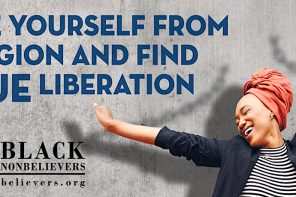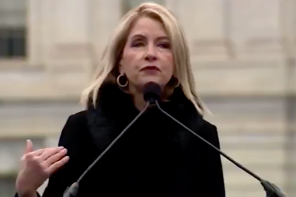Recently, there’s been a lot of talk in the organized atheist, humanist, skeptic and freethought movements about the potential benefits and drawbacks of interfaith work.
Over at Patheos, the Executive Director of the American Humanist Association, Roy Speckhardt, recently made an excellent case that while the terminology of “interfaith” may be problematic and there are several other important issues to grapple with, it is worth atheists’ while to get involved. At Friendly Atheist, Secular Student Alliance Communications Director Jesse Galef offered a long list of reasons atheists might participate, and how their involvement might improve some of the problems within the interfaith movement. Despite Galef and Speckhardt’s serious concerns and reservations, they have been actively involved in intentionally interfaith efforts, and I suspect their participation has informed their conclusions about the idea.
However, those speaking out against atheist involvement in the interfaith movement are, at the moment, a bit more numerous (just a couple of examples, with several others to follow). As far as I can tell based on what many atheists opposed to interfaith involvement state in their writing, a large percentage of them seem to have kept their distance from interfaith work. I understand their hesitation given the criticisms they offer, but I can’t help but wonder if there is some disconnect when those who criticize the interfaith movement the most also seem to have had little to no actual experience with it. I could be wrong, but I’d be surprised if someone who had been involved in interfaith work would suggest, as prominent atheist blogger P.Z. Myers did, that it “cheerfully and indiscriminately embrace[s] every faith without regard for content.”
Present in almost every atheist blog I’ve read opposed to interfaith work are perhaps the most common critiques I hear from my fellow atheists regarding interfaith work, and they’re directly related: that interfaith leaves no room for religious criticism, and that it by default excludes atheists because atheism isn’t a “faith.” Most atheists I know who reject the idea of participating in interfaith work do so in part because they assume that, in order to participate, everyone must bite his or her tongue and play nice, and that participation in this kind of movement lends our implicit approval to “faith” as a concept and rallying point.
I’d like to explain why I think these concerns may be somewhat overblown; how they might be combated where they exist, and the reality that they actually don’t apply to most situations.
Isn’t interfaith just a pro-religion ‘kumbaya’ club?
A recent expression of these concerns was made in a blog by Ronald A. Lindsay, president and CEO of the Center for Inquiry, an organization I have worked with a number of times (I recently accepted an invitation to join their Speakers’ Bureau) and whose “Living Without Religion” campaign I greatly admire. In his blog, Lindsay wrote that “it’s nice that some politicians are finally willing to acknowledge our existence, but are we so desperate for acceptance that we’ll allow others to condescendingly misdescribe us as adherents of a faith? Sorry, but I can’t get too excited about being permitted to drink at the Whites Only fountain because we can ‘pass.’” I’ll set aside my distaste for the bizarre (and far too common) parallel made between the atheist movement and the civil rights movement and address the meat of the argument: the fear that, in order to maintain the “kumbaya” status quo, atheists need to keep quiet about their beliefs about religion.
Lindsay continued:
“it is probably true that working together with religious groups in interfaith coalitions will result in some good will and more favorable opinions about atheists… But this benefit has to be weighed against the cost. The mission of secular organizations is, presumably, not just to get atheists to be liked. Among other things, it’s to promote critical reasoning; it’s to advance the view that faith is decidedly not a virtue. Calling our worldview a faith does not seem the best way to achieve these objectives.”
Unsurprisingly, the thought that interfaith work requires significant tongue-biting makes many atheists very uncomfortable; it was certainly a concern I had before I started working in the interfaith movement.
The irony of this worry is that the atheist and the interfaith movements actually share a common point of origin: they both started, in part, as a reaction to religious extremism. Much like the atheist movement, the interfaith movement seeks to build inter-group understanding, encourage critical thinking, and end religiously-based sociological and political exclusivism. The fundamental misunderstanding that many atheists have is that they imagine the interfaith movement as uninterested in combating religious totalitarianism and solely existing to maintain religious privilege—as an excuse to show that religion, in its many diverse forms, has a monopoly on morality—but that couldn’t be further from the truth.
In my experience, interfaith work exists to bring diverse religious and nonreligious people into common work to build relationships that might deconstruct the kind of “us vs. them” thinking that contributes to exclusivistic religious hierarchy. It is a place to challenge and question, but to do so constructively.
The success of such challenges is contingent on whether invested relationships exist between the involved parties; otherwise, disagreements run the risk of degenerating into shouting matches in place of reasonable discourse. In “E Pluribus Unum: Diversity and Community in the 21st Century,” Robert Putnam wrote that diversity is important to build strong and sustainable communities. But, at least at first, people tend to “hunker down” with those very similar to themselves and gaze upon others with suspicion. For diversity to flower, individuals must meet and learn from one another.
Similarly, in Ethnic Conflict and Civic Life: Hindus and Muslims in India, Ashutosh Varshney theorized that the likelihood that inciting events would lead to widespread or long-term violence was significantly less in communities where civic ties across lines of religious identity were present. In populations where such ties were nonexistent, inciting incidents provoked extensive inter-group violence. And while atheists and the religious in the United States don’t regularly commit physical violence against one another, it is clear that invested relationships across lines of identity difference are essential for cooperation and constructive inter-group communication, whether those groups are religious or not.
Whether it is engaging Christians around my negative experiences as a former evangelical and a queer person, or challenging my religious peers to rationally explain their beliefs, I’ve found interfaith work to not only be a fruitful place for such conversations, but the ideal forum for it. I can fondly recall any number of incidents where I argued theology and philosophy with a religious colleague while doing interfaith work; and how, later, they told me that they actually took my perspective seriously because we had built a trusting relationship. It made all the difference that I treated them as intellectual equals—as people with respectable goals rather than just mindless adherents of some stupid religion. They had heard positions similar to mine in the past from other atheists, but they had been presented so disrespectfully that they had made no impact, and had closed them off from even entertaining such ideas in some cases.
This is precisely what interfaith work sets out to do: elicit civil dialogue to increase understanding, not stifle it for the sake of “playing nice.”
But Atheism Isn’t a ‘Faith’…
As Lindsay articulated, there is a related concern that many atheists have about joining interfaith coalitions—that participating in interfaith work somehow bolsters religious privilege. And, all the more, that some will conflate atheists participating in interfaith work with the idea that atheism is “just another religion,” when some of the underlying values of a religious mindset are exactly what many atheists reject.
“In participating in interfaith coalitions, atheists are implicitly allowing atheism to be considered just another religion,” wrote Lindsay. I can only speak from my experience here, but I have been invited to address interfaith conferences and groups many times, and I often open with this line: “Let’s get one thing out of the way—atheism and humanism aren’t a religion.” Not once have I had anyone disagree with me.
To atheists concerned about being seen as “just another faith” and worried that interfaith isn’t an avenue for substantive discourse: I encourage you to give it a shot anyway, and be vocal about where you stand. I cannot begin to recount all of the times interfaith work has opened up a space for robust conversations on problematic religious practices and beliefs—in fact, it has been a hallmark of my experience working in the interfaith movement. All the more, it has allowed me to engage religious people about atheist identity and eradicate significant misconceptions about what atheism is and what it isn’t.
I regularly hear from atheist students who are leading the charge for interfaith cooperation on their campuses, and their experiences echo mine. I’ve spoken on the topic of atheism and interfaith work at fourteen colleges and universities in the last two months, which gave me many opportunities to see it in action. Last month, Tufts’ Freethought Society hosted a panel on the role of atheists in interfaith efforts. I was fortunate enough to sit on the panel alongside experienced interfaith activists like Rabbi Or Rose, Valarie Kaur, Jen Bailey, and Chris LaTondresse (with whom I later, over a beer, debated about the existence of Christ).
Eboo Patel, Founder and President of the Interfaith Youth Core (IFYC), created a video to kick off the event, and in it he said: “Interfaith work in America and the world is incomplete without the presence, the participation, and the contributions of Secular Humanists.” It couldn’t be any clearer that our perspective, with all of the challenge it may present to the religious, is wanted in interfaith work.
The question, then, is: will we take up the call? Or will we sit on the sidelines listing off reasons why we don’t belong?
An atheist blogger I really admire, Blag Hag author Jen McCreight, recently wrote that she has a problem with “the interfaith people who say the debaters and the intellectuals need to shut up and just sing kumbaya with religion.” Those people may exist, but I haven’t met many—and the only way to ensure that there is a place for compassionate but challenging discourse in interfaith work is for those who hold it in esteem to actually show up.
In my experience, interfaith work doesn’t require that people check their convictions at the door; it invites people to try to understand and humanize the other. It’s a worthy goal, and if the only thing keeping some atheists from participating is a semantic disagreement with the word “faith,” I think that is a missed opportunity.
Wondering if interfaith cooperation is more than just “kumbaya”? Try it out and let me know what you experience. Your conclusions about the importance of interfaith work very well might not match mine, but I’d love to get your feedback.
Based on my own work in the interfaith movement, I’m hopeful that other atheists will find themselves pleasantly surprised. As my mom always said when, as a child, I protested eating an unfamiliar food: “Don’t knock it til you try it.”
(For a more in-depth exploration of why atheists might get involved in interfaith work, check out a series of posts I wrote for The New Humanism, or this excellent post by the Secular Student Alliance’s Director of Campus Organizing, Lyz Liddell.)




